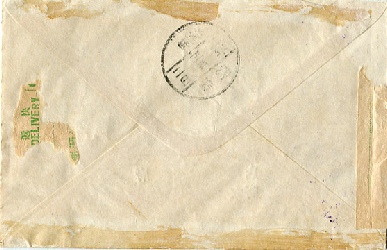
Cliquez sur les images pour agrandir -

LETTRE
1er mars 1935 -
–
March 1st, 1935 -
|
Dimensions : |
148 x 95 mm |
|
|
Tarif : |
Lettre pour la Chine par 20g……. Surtaxe par Exprès……………… Total……………………………… Sur- |
4 fens 8 fens 12 fens 14 fens |
|
Période de valeur : |
10/01/1935 au 31/03/1937 |
|
|
Timbres utilisés : |
YT n° 51 à 54 |
|
|
Oblitération : |
Commémorative n°11, Moukden 01/03/1935 |
|
|
Période d’utilisation : |
Du 1er au 3 mars 1935 |
|
|
Indication : |
« Exprès » bilingue français chinois |
|
|
Arrivée : |
Oblitération Jinsien 2/03/1935 |
|
|
Size : |
148 x 95 mm |
|
|
Rate : |
China letter per 20g……………. Express fee…………………….. Total…………………………….. Overpaid………………………… |
4 fen 8 fen 12 fen 14 fen |
|
Period of rate : |
01/10/1935 to 03/31/1937 |
|
|
Stamps : |
SG n°57 to 60 |
|
|
Postmark : |
Comemorative cancellation n°11, Mukden 03/01/1935 |
|
|
Period of use : |
March 1st to 3rd, 1935 |
|
|
Instruction : |
« Exprès » bilingual french chinese |
|
|
Arrival : |
Postmark Jinsien 03/02/1935 |
|
De part sa présentation, un timbre dans chaque coin de l’enveloppe et oblitérations nettes, ce courrier est philatélique. Ce qui explique le sur-
Les quatre timbres sont la première série de timbre-
L’oblitération commémorative marque le troisième anniversaire de la fondation de l’État et le premier anniversaire de l’établissement du gouvernement Impérial. Elle fut utilisée dans 15 bureaux de poste.
A noter que l’étiquette « Exprès » est restée collée au dos de l’enveloppe avec le fragment d’une seconde.



In terms of presentation, with a stamp in each corner of the envelope and clear cancellations, this mail is philatelic. This explains the 14 fen postage surcharge -
The four stamps are the first series of "nameless" postage stamps. They are the result of part of the Sino-
The commemorative cancellation marks the third anniversary of the founding of the State and the first anniversary of the establishment of the Imperial government. It was used in 15 post offices.
Note that the "Express" label is stuck to the back of the envelope, along with a fragment of a second.